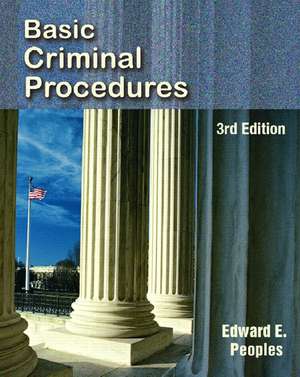Basic Criminal Procedures
Autor Edward E. Peoplesen Limba Engleză Paperback – 30 iun 2006
Preț: 613.98 lei
Preț vechi: 758.00 lei
-19% Nou
Puncte Express: 921
Preț estimativ în valută:
117.48€ • 122.66$ • 97.23£
117.48€ • 122.66$ • 97.23£
Carte indisponibilă temporar
Doresc să fiu notificat când acest titlu va fi disponibil:
Se trimite...
Preluare comenzi: 021 569.72.76
Specificații
ISBN-13: 9780131731929
ISBN-10: 0131731920
Pagini: 226
Dimensiuni: 206 x 255 x 14 mm
Greutate: 0.53 kg
Ediția:3Nouă
Editura: Prentice Hall
Locul publicării:Upper Saddle River, United States
ISBN-10: 0131731920
Pagini: 226
Dimensiuni: 206 x 255 x 14 mm
Greutate: 0.53 kg
Ediția:3Nouă
Editura: Prentice Hall
Locul publicării:Upper Saddle River, United States
Descriere
For freshman/sophomore level courses in Criminal Procedures.
Basic Criminal Procedures, Third Edition explains the procedural aspects of the criminal justice system systematically, making the concepts easy to apply to any state’s specific procedural laws. It is ideal for freshman/sophomore level courses in criminal procedures because its writing is clear, its appellate excerpts and citations are understandable, and it introduces unfamiliar concepts and terms before they are discussed within the chapter. This edition continues its detailed coverage of the Exclusionary Rule and the Miranda procedures, includes compelling human-interest stories and offers more balanced coverage of consensual encounter, detention and arrest.
Basic Criminal Procedures, Third Edition explains the procedural aspects of the criminal justice system systematically, making the concepts easy to apply to any state’s specific procedural laws. It is ideal for freshman/sophomore level courses in criminal procedures because its writing is clear, its appellate excerpts and citations are understandable, and it introduces unfamiliar concepts and terms before they are discussed within the chapter. This edition continues its detailed coverage of the Exclusionary Rule and the Miranda procedures, includes compelling human-interest stories and offers more balanced coverage of consensual encounter, detention and arrest.
Cuprins
Preface
Chapter 1 Criminal Procedures in Perspective
Chapter 2 Fundamental Concepts of Law
Chapter 3 The Exclusionary Rule
Chapter 4 Police-Citizen Transactions: Consensual Encounters and Detentions
Chapter 5 The Laws and Procedures of Arrest
Chapter 6 Miranda: Its Meaning and Application
Chapter 7 Booking and Custody Procedures
Chapter 8 The Adversary System: Roles of the Prosecution and Defense
Chapter 9 The Court Structure and Pretrial Procedures
Chapter 10 The Trial Procedures
Chapter 11 Defense Strategies and Trial Outcomes
Chapter 12 Sentencing Procedures and Alternatives
Chapter 13 Post-Sentencing Procedure
Subject Index
Case Index
Caracteristici
For freshman/sophomore level courses in Criminal Procedures.
Basic Criminal Procedures, Third Edition explains the procedural aspects of the criminal justice system systematically, making the concepts easy to apply to any state’s specific procedural laws. It is ideal for freshman/sophomore level courses in criminal procedures because its writing is clear, its appellate excerpts and citations are understandable, and it introduces unfamiliar concepts and terms before they are discussed within the chapter. This edition continues its detailed coverage of the Exclusionary Rule and the Miranda procedures, includes compelling human-interest stories and offers more balanced coverage of consensual encounter, detention and arrest.
Criminal procedures are presented in sequential steps–making them easier to understand.
Basic Criminal Procedures, Third Edition explains the procedural aspects of the criminal justice system systematically, making the concepts easy to apply to any state’s specific procedural laws. It is ideal for freshman/sophomore level courses in criminal procedures because its writing is clear, its appellate excerpts and citations are understandable, and it introduces unfamiliar concepts and terms before they are discussed within the chapter. This edition continues its detailed coverage of the Exclusionary Rule and the Miranda procedures, includes compelling human-interest stories and offers more balanced coverage of consensual encounter, detention and arrest.
Criminal procedures are presented in sequential steps–making them easier to understand.
- Examines procedures systematically, beginning from the point of an individual’s first contact with police, through the law enforcement process, the courts, the correctional system, and back into the community on probation or parole.
- Illustrate the human element to case law by interjecting personal information about the lives of the characters discussed in these decisions.
- Defines terms and helps students develop fluency in the legalese that is used by professionals in the field.
- Shows how and why our current procedures exist.
Caracteristici noi
New! Consensual encounter, detention and arrest–are now covered in two chapters.
- Spreads coverage over two short chapters (instead of one long one) to better fit the structure of a semester long course.
- Discusses various aspects of consensual encounter and detention in Chapter 4 and then focuses on arrest in Chapter 5.
- Examines the balance between freedom and security and shows the basic concepts that impact the procedural aspects of our justice system.
- Includes decisions from the 2004-2005 Supreme Court term.
- Provides summaries and citations from appellate decisions using an accessible approach that is more understandable than competing texts.
- Presents two alternatives to formal prosecution–diversion and deferred prosecution–so readers can get a more critical overview of the topic.
